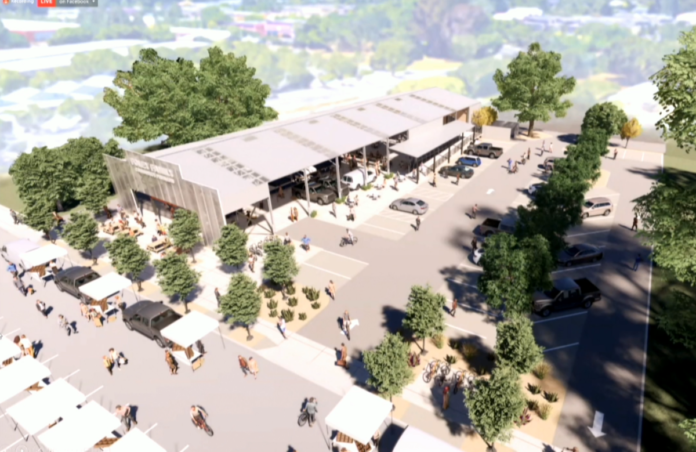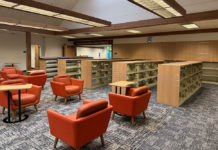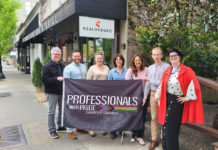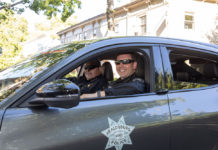In a unanimous motion made by the Healdsburg City Council on Aug. 16, the revised roof design for the Foley Family Community Pavilion on North Street was approved, launching the project into the CEQA and design review phase.
Following the environmental and design review process, construction plans and drawings can finally be drawn up for the long-awaited project, setting the scene for future construction.
Instead of having more of an open air roof, the historic building will feature a mix of solid and translucent panels with an industrial aesthetic that will match the overall rustic/agricultural design and feel of the structure.
The panels will allow for some natural light to filter through while controlling the heat.
As for the current structure, the interior truss system is in pretty good condition, however the exterior will need some work. The goal is to repurpose the interior trusses according to Healdsburg Community Services Director Mark Themig.
In March 2020, the city council considered a $7 million pledge from the Foley family to create a community event/farmers market space and pavilion out of the old Purity building on North Street.
After considering various project options, including affordable housing, the city council voted unanimously in favor of working with the Foley Family Charitable Foundation to prepare a mutually agreeable commitment letter to accept the pledge and move forward with the pavilion project.
Additionally, the city council directed the design team to explore extending the roof area across the entire pavilion structure in order to make the site work better for year-round use.
The council also wanted to ensure that a Sonoma-Marin Area Rail Transit (SMART) train station could fit at the site.
“The train station can fit, but the decision about where the train station would be developed will be a future decision that SMART and the city council will have to make,” Themig said.
One of the other key components of the pavilion is to make sure it is a good fit for the Healdsburg Farmers Market since the site will be the future permanent home of the market.
“We’ve spent a lot of time working on this concept of the fit for the farmers market. This site is configured differently than they have currently where they have three aisles. We have more site constraints here with the existing structure and we have a bit smaller parking area,” said Themig.
He said city staff and designers have done several exercises to demonstrate that the market can fit at the pavilion and while it will be able to fit, staff and stakeholders concluded that the closure and use of North Street will be needed during portions of the year to accommodate the market.
“To make the site function really well for the farmers market and for the community, it will require the regular closure of North Street during those peak market times. Typically, that would be the summertime when there are more vendors. During other times of the year, they may not need to close North Street,” Themig said.
The history of the site and honoring its legacy
The site was purchased in 2004 by the city’s former redevelopment agency with the intent to use the property to help meet the city’s increasing downtown parking needs.
In 2007, the former redevelopment agency board initiated actions to demolish the structure and build a parking lot, however, there was much community opposition to the idea and residents did not want to lose such a big piece of Healdsburg’s agricultural identity and history.
The site was used in the 1920s as a fruit distribution center where fruit, such as prunes and cherries, were canned and sent down on trains. Later, the site, formerly known as the Cerri Site, was home to a fruit cannery when it was purchased by Del Monte.
“We had an opportunity to sit down with Holly Hoods from the museum and talk about the context of this particular structure and its importance to Healdsburg. It turns out its importance to Healdsburg goes beyond just Healdsburg,” Themig said. “It was an era of time for California when production and canning of fruit products was so important to the rest of America that the railroad became an important critical function.”
Hoods found labels from a number of canneries that were in the Healdsburg area that displayed their fruit and was sold across the country.
Themig said it would be nice to incorporate some of the labels and cannery history into the design of the building through art in order to honor its historical significance.
Councilmember Ariel Kelley said she would like to see Healdsburg’s arts and culture heritage articulated in the space but would like to focus on honoring the local farmworkers.
“I think it would be a missed opportunity to not educate the community about the farmworkers who live in our community, who have historically been here and have been part of the creation of this as an agricultural community,” Kelley said. “I think, while those are cute labels and the history of the canning is bright and colorful, I think we should also be talking about the human element of the history that continues to make this an agriculturally relevant community in the world.”
Vice Mayor Ozzy Jimenez agreed with Kelley and said he’d like to see a multicultural art component to the project.
“It is a long-known fact that many of the benefits that we are receiving in our community today is because of farm ag workers, specifically ag workers of color, so for me it is really important for everyone in our community to see the many contributions that the many others have given in our town,” Jimenez said. “I just would hope that that is kept in mind, is how do we honor the multicultural legacy of our community through this community building?”
Other pavilion amenities include unisex bathrooms on site, storage and a catering kitchen. The bathrooms would be open to the public during the facility hours. In terms of water usage, Themig said the site will have low flow toilets and sinks.
Jimenez asked if city staff explored whether or not solar panels could be installed on the roof and Themig said the idea was looked at, however, it was determined that there would not be enough structural support for the panels and that the building’s alignment isn’t ideal for solar.
“This is a great project,” Healdsburg resident Mark McMullen said during the public comment period. “I am really excited to see it move forward. I hope the project will move forward efficiently.”
Healdsburg Mayor Evelyn Mitchell echoed McMullen’s comments and voiced that it’s exciting to see progress on this long-awaited project.
“This is getting exciting. Someday we’re going to see it built,” Mitchell said.










